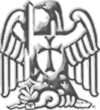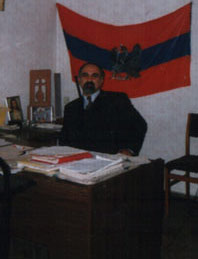
USD
UNION FOR SELF-DETERMINATION(CHRISTIANOCRATS)
| Armenian Version | USD President << Home |
 |
USDUNION FOR SELF-DETERMINATION(CHRISTIANOCRATS) |
||
|
|||
| USD President | ||||
PARUYR HAYRIKYAN
|
| A descendant of natives of Van and Constantinople, Paruyr Hayrikyan was born on July 5, 1949 in Yerevan. Hayrikyan's education was at public schools in Noubarashen (near Yerevan) from which he graduated in 1966. The same year, he was admitted to the Yerevan Polytechnic Institute. He attended night classes at the Institute while working days as an electrician at the Noubarashen-based knitted wear factory.
While he was in school, Hayrikyan established the Union of Armenian Youth (UAY). The Union's major activity was dissemination of educational and patriotic leaflets. In the spring of 1967, while he was a student, Hayrikyan was detained for the first time by KGB agents, and released immediately after interrogation. Hayrikyan established contacts with the leaders of the National United Party founded in April 1966 by painter Haykaz Khachatrian. After making the acquaintance of Shahen Haroutiunian and Stepan
Zatikian (the latter was sentenced to death by firing squad on framed-up
charges) Hayrikyan and 4 members of the UAY were admitted to the
NUP. As a member of the NUP Hayrikyan founded a new youth organization
called ,,Shant,,. ,,Shant,, developed its program and rules. The
first precept in Shant's program called for a ,,...struggle against
Moscow's colonial policies.,, Members of the Shant organization
elected their leadership and disseminated leaflets. |
 |
On April 24, 1968, the 53rd anniversary of the Genocide of Armenians in Turkey, Hayrikyan and his friends managed to organize a radio program in Yerevan's Tsitsernakaberd Park, where the monument to the victims of genocide is located. In July 1968, the KGB uncovered the National United Party and arrested its founder H. Khachatrian and his close friends Haroutiunian and Zatikian (the latter was directing Hayrikyan's activities). Hayrikyan became a leader of the NUP and launched an active campaign aimed at resorting the organization and recruiting new members to the Party. He managed to establish 12 groups of the NUP, united under two affiliates, namely "Erkounk" (Torments) and "Tsasoum" (Wrath) and to publish 5,000 copies of Erkounk newspaper. The newspaper bore the motto: "Free Armenia or Death!" On March 29, 1969, Hayrikyan was arrested by KGB agents at one of the NUP's secret apartments.
 |
The investigation lasted for 10 months. In February 1970 Hayrikyan, who at that time was under 21, together with 4 friends, was arraigned before the court. As a leader of the organization, Hayrikyan was sentenced to 4 years in prison. Hayrikyan served his term in a special camp for political prisoners in Mordovia. After returning from prison in 1973, Hayrikyan updated the party's program by focusing on the respect for human rights and the process of popular referendum as the road to democracy and independence. On February 12, 1974, he was again arrested. On November 22, 1974, the court sentenced Hayrikyan to 7 years prison and 3 years exile. The trial lasted for 25 days. During the trial Hayrikyan conducted himself as a consistent follower and supporter of independence and civic rights. In his statement to the court, which lasted for 2 days, Hayrikyan substantiated his position and lawfulness of his demands regarding independence of Armenia from the USSR. Those attending the trial were deeply moved by Hayrikyan's last words: "I am very fond of life. I love it even more than one can imagine. But while Armenia is not free and while I am alive, prison will be my place of residence... I do not pin any hopes on the court, but I am going to defend my Homeland and fair demands of my people with the last drop of my blood... Long live Armenia's sacred right to independence!" During Hayrikyan's second period of imprisonment, the NUP being the only surviving political party in the Soviet Union, became an international organization by virtue of its membership: almost all political prisoners who refused to compromise or cooperate with the KGB officially joined the NUP. They included the Ukrainians Vichislav Chornovil, Vasil Stoos, Ivan Guel, Irina Kalinetz; the Jews Edik Kuznetsov, Mikael Haifitz; the Russians Sergei Soldatov, Piotr Sartakov; and representatives of other nations. |
Starting February 12, 1977, Hayrikyan for the first time openly declared that he had been a leader of the National United Party and went on a hunger strike in the prison camp, demanding that all members of the NUP be released from prisons, that the NUP be legalized, and that a national referendum be called. This action and his other activities in prison resulted in new persecutions of Hayrikyan, and now criminal cases were manufactured against him.
In 1984, after 14 years of imprisonment (which included 6 years and 7 months in prisons, another 6 years and 7 months in camps, and 304 days in solitary confinement) Hayrikyan was exiled to Ust-Kout in the Irkoutsk region (to the north of Baikal Lake), where he lived until the beginning of 1987. In the fall of 1987, Hayrikyan returned to Yerevan and together with his friends established the Union for National Self-Determination (UNSD). UNSD's major objective was to achieve Armenia's independence through the peaceful declaration of self- determination in a nationwide referendum.
In February 1988, Hayrikyan was transmitting comprehensive and detailed information to the West, thus, overcoming the information blockade in the USSR. With the beginning of the Karabakh movement all UNSD's structures became a part of the movement. In March 1988, Hayrikyan went to Moscow where he called a series of news conferences accusing the USSR leadership of organizing pogroms of the Armenian population in Sumgait. He was then arrested, escorted to Yerevan, and handed over to the Armenian KGB. He was kept in KGB custody for 4 months. However, law enforcement officials failed to make a case against Hayrikyan. Under the decree of the Presidium of the USSR's Supreme Council, Hayrikyan was stripped of Soviet citizenship and exiled to Ethiopia. The US State Department immediately offered him political asylum. With the assistance of the Armenian community of Ethiopia, Hayrikyan went to Italy, then to France and Germany.
The USA was the last stop in his long travels. In the fall of 1988, Hayrikyan's wife and three children joined him in the United States. The next year Hayrikyan's mother ( his father-Arshavir Hayrikyan-died in fall of 1987 ) and his sister (widow of Stepan Zatikian sentenced to death by firing squad) and her children also joined him. During his stay in the United States, Hayrikyan maintained his ties with the UNSD and actively lobbied the issue of Nagorno Karabakh in the West, including active lobbying within the US Congress. He demanded that political persecutions of the Karabakh Committee's members be stopped.
During his stay abroad, Paruyr Hayrikyan acquired wide popularity. He was elected Chairman of the international organization ,,Democracy and Independence,,. On May 20, 1990, while Hayrikyan was still in exile in the USA, he was elected a member of the Armenian Supreme Council from the Parakar district. In July 1990, Hayrikyan was nominated in absentia for the post of the Supreme Council Chairman, losing, however, to Levon Ter-Petrossyan. In August of 1990, Senator Bob Dole led forty US senators in pressuring Gorbachev to restore Paruyr Hayrikyan's Soviet citizenship. Further pressured by the Armenian Parliament, the Kremlin restored Hayrikyan's citizenship in November 1990 and allowed him to return to Armenia. He returned to Armenia, while his wife chose to stay in the USA with the couple's three children. In January 1991, Hayrikyan, as the president of the Coordinating Center of the national democratic movement of the USSR, Democracy and Independence, led a demonstration of representatives of all Soviet republics, in front of the Norwegian Embassy in Moscow. This was a protest against awarding Michael Gorbachev the Nobel Peace Prize in light of the repressive events in Vilnius. Later that year, on July 4 in front of the US Embassy in Moscow, Hayrikyan led another demonstration of national democratic movement representatives calling, "We want our own 4th of July!"
In May-June 1991, the Armenian Supreme Council held debates on the issue of introducing presidential rule in the country. Hayrikyan and some of his supporters convinced the MP's of the necessity to establish the Office of President in Armenia as well as the separation of powers among branches of the government. In October 1991, Hayrikyan stood for the Office of President. Judging by election returns, Hayrikyan ranked second after Levon Ter-Petrossyan, but his supporters claimed that there were multiple violation during the campaign, including an act of violence committed against him and his supporters in the village of Paravakar (Tavoush District). These charges were subsequently judged to be true by decision of the Armenian courts.
In the summer 1992, Hayrikyan was appointed Commandant of Goris region and served in that office for a year. Together with his supporters, Hayrikyan took measures to ensure the efficient defense and organizing settlements of refugees in the Syunik region. On July 5, 1995, Hayrikyan was re-elected to the Armenian Parliament as a leader of the UNSD faction.
Hayrikyan speaks Russian, English and Latvian, and has a good command of French, Ukrainian and Lithuanian. He has written many songs (often sung at Union for National Self-Determination rallies), marches and verses chiefly written while he was in prison.
Copyright © 2001- USD.